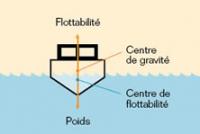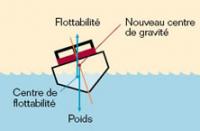Transport Publication TP 14070 E (2010)
- Table of Contents
- Document Information
- Who Should Read This Guide?
- Introduction
- Chapter 10
- Chapter 2
- Chapter 3
- Chapter 4
- Chapter 5
- Chapter 6
- Chapter 7
- Chapter 8
- Chapter 9
- Chapter 10
- Chapter 11
- Chapter 12
- Chapter 13
- Chapter 14
- Chapter 15
- Chapter 16
- Chapter 17
- Appendix 1
- Appendix 2
- Appendix 3
- Appendix 4
- Appendix 5
Stability refers to a vessel’s ability to resist capsizing by returning to an upright position after being heeled over (tilted to one side due to wind or sea conditions). Many forces affect vessel stability and each type of vessel reacts differently to heeling forces. The owner is responsible for ensuring that the vessel has adequate stability to safely carry out its intended operations. As a result, you need to know how your vessel with its load interacts with outside forces of nature and what affects its stability. For example, open boats and vessels with large well decks may tend to ship water and/or downflood (when water enters the hull from above deck or over the gunwale), making them less stable.
Vessels built or converted to non-pleasure use on or after April 1, 2005, must comply with the stability requirements of section 717 of the Small Vessel Regulations. For information on how to assess the stability of a vessel built or converted to non-pleasure use before April 1, 2005, refer to Ship Safety Bulletin 07/2006: Guidance for Assessing Intact Stability and Buoyancy of Existing Small Non-pleasure Vessels.
A properly designed and loaded vessel should resist heeling forces when operated within its design limitations (see Figures 8-1 and 8-2).
Adding weight above a boat’s centre of gravity will raise the centre of gravity and decrease stability. As the centre of gravity is raised, less heel is required to capsize the vessel (see Figures 8-3 and 8-4). Removing weight from below the centre of gravity may also make the vessel less stable.
The best way to prevent a boat from capsizing is to operate a well designed, maintained and loaded vessel with an experienced crew.Preventing unstable vessel conditions and being able to recognize the warning signs when such conditions do occur can save lives. Be on constant watch for loss of stability (see Warning Signs of Instability). Consult a marine professional to determine the impact on stability of modifications you are thinking of doing before you go ahead.
Precautions
Of all accident types, founders and capsizes caused by a loss of stability are the most likely to lead to death on the water. Many of these accidents can be avoided.
A well-designed vessel will resist capsizing or foundering in severe conditions if it is operated properly. Keep these rules in mind:
- Be aware of outside forces: wind, waves and water depth. Always check the weather forecast before setting out and avoid rough weather conditions.
- Don’t overload your vessel. Be aware of the amount of weight added to your vessel and available freeboard. Place people and cargo evenly.
- Make sure that all cargo, tools and equipment are well secured during the entire voyage. It is a lot safer and simpler to remove well-prepared lashings after a successful voyage, than to try to add lashings in poor weather while a vessel is rolling and pitching. Store cargo below deck if you can.
- Reduce both the amount of liquids/cargo that are able to move and the area in which they can slosh back and forth by using smaller tanks and by subdividing cargo holds, because partly-filled water and fuel tanks and cargo holds can make your vessel unstable.
- Prevent water from getting into your vessel by keeping hatches, doors and windows closed, as much as you can, when underway. Regular maintenance of seals and fastening devices will help to ensure watertightness.
- Remove water as quickly as possible. Scuppers and drains must meet design standards and be kept in good working order.
- Do not perform operations such as lifting or towing unless the stability of your vessel has been assessed under these conditions.
- Adjust course, speed, or both if you can, to reduce the vessel’s rolling motion.
- Avoid sharp turns or turns at high speed.
- Consult a marine professional before making changes, because modifications to your vessel may affect its stability. Have the stability information revised to reflect any changes you make to the vessel.
Warning Signs of Instability
- Your vessel's handling changes. For example, it seems sluggish, rolls more or rolls more slowly.
- Your vessel is listing to port or starboard or is trimmed more than usual by the bow or stern.
- There is less freeboard than you would expect normally. If so, check tanks and holds for flooding or cargo shift.
- The bilge pumps are working more frequently than usual. If this happens, check the bilges for water and that bilge pumps and alarms are working properly.
- The bilge alarm is sounding.
With no heel the downward force of
gravity is equal and opposite the
upward force of buoyancy.
Buoyancy and gravity bring the
boat upright.
Weight added above the centre of
gravity reduces the righting ability
of the vessel.
Centre of gravity located too high
will cause the boat to capsize.
Freeboard
Freeboard is the distance between the water and the watertight deck of your vessel, or the gunwale (upper edge of the hull) if it’s an open boat without scuppers (see Figure 8-5). If the deck edge goes under water when the vessel heels, its stability will decrease rapidly and the danger of capsizing will increase. If the gunwale of an open boat is going under water, there is an imminent risk of capsizing. An overloaded vessel’s freeboard will be smaller and the deck edge or gunwale may go under water with even a slight heel.
You need a safe freeboard height, so take care not to overload your vessel.
Free Surface Effect
When a vessel with a full tank heels over, the tank’s centre of gravity does not change, so the vessel’s stability is not affected. Water on deck, liquids in holds and partly filled tanks and bilge water, however, will shift with the movement of the boat. When this happens, the centre of gravity will also shift, making the vessel less stable. This "free surface effect" reduces stability and increases the danger of capsizing (see Figure 8-6).
If you want to test the "free surface effect" in your own home, fill a glass of water and walk across the kitchen. You should have no trouble doing so without spilling any water. Next, pour the same amount of water into a cookie sheet and carry it across the kitchen. It’s harder to keep the water in or on the cookie sheet. That’s because the large free surface allows the water to slosh over a greater surface.
It is good practice to reduce free surface effect by dividing tanks with baffles and fluid cargo holds with bulkheads, and by having as few partly filled tanks and holds as you can.
Free Surface Math
Free surface effect (FSE) increases with the cube of the breadth of the free surface. If you divide the breadth of a tank by half (for instance, by installing a watertight internal baffle), each half has a free surface that is about eight times less. The total free surface effect (the sum of the two sides) is therefore diminished by a factor of four.
Free Surface Effect = breadth x breadth x breadth x length / 12
For a tank that is 4 metres wide and 3 metres long, the FSE is 16 (4 x 4 x 4 x 3 / 12).
If you add a baffle at the tank's mid-point, you turn it into two tanks, each 2 metres wide. The free surface effect for each tank is 2 (2 x 2 x 2 x 3 / 12), making a total FSE of 4 for the two tanks together – one-quarter of the FSE for the tank with no baffle.
More Information
Contact your local Transport Canada Centre to find out the laws and regulations that apply to your vessel and situation (see Appendix 2).
-
Cargo, Fumigation and Tackle Regulations
www.laws.justice.gc.ca/en/SOR-2007-128/ -
Small Vessel Regulations
http://laws-lois.justice.gc.ca/eng/regulations/SOR-2010-91/ -
Construction Standards for Small Vessels (TP 1332)
www.tc.gc.ca/eng/marinesafety/tp-tp1332-menu-521.htm -
Ship Safety Bulletin 07/2006: Guidance for Assessing Intact Stability and Buoyancy of Existing Small Non-pleasure Vessels
www.tc.gc.ca/eng/marinesafety/bulletins-2006-07-eng.htm -
Transport Canada Marine Safety Vessel Stability web page
www.tc.gc.ca/eng/marinesafety/debs-vessel-stability-menu-1193.htm







